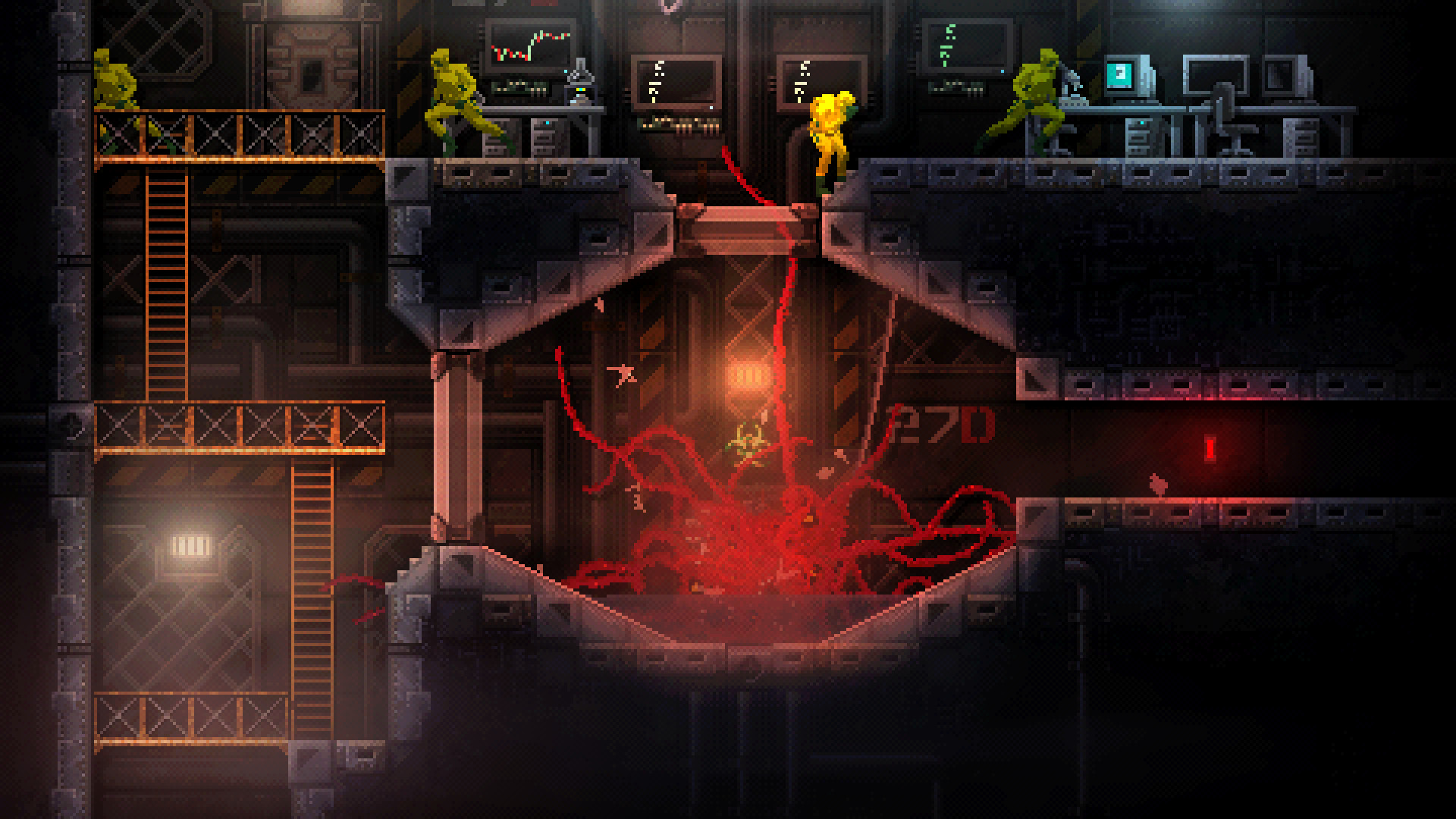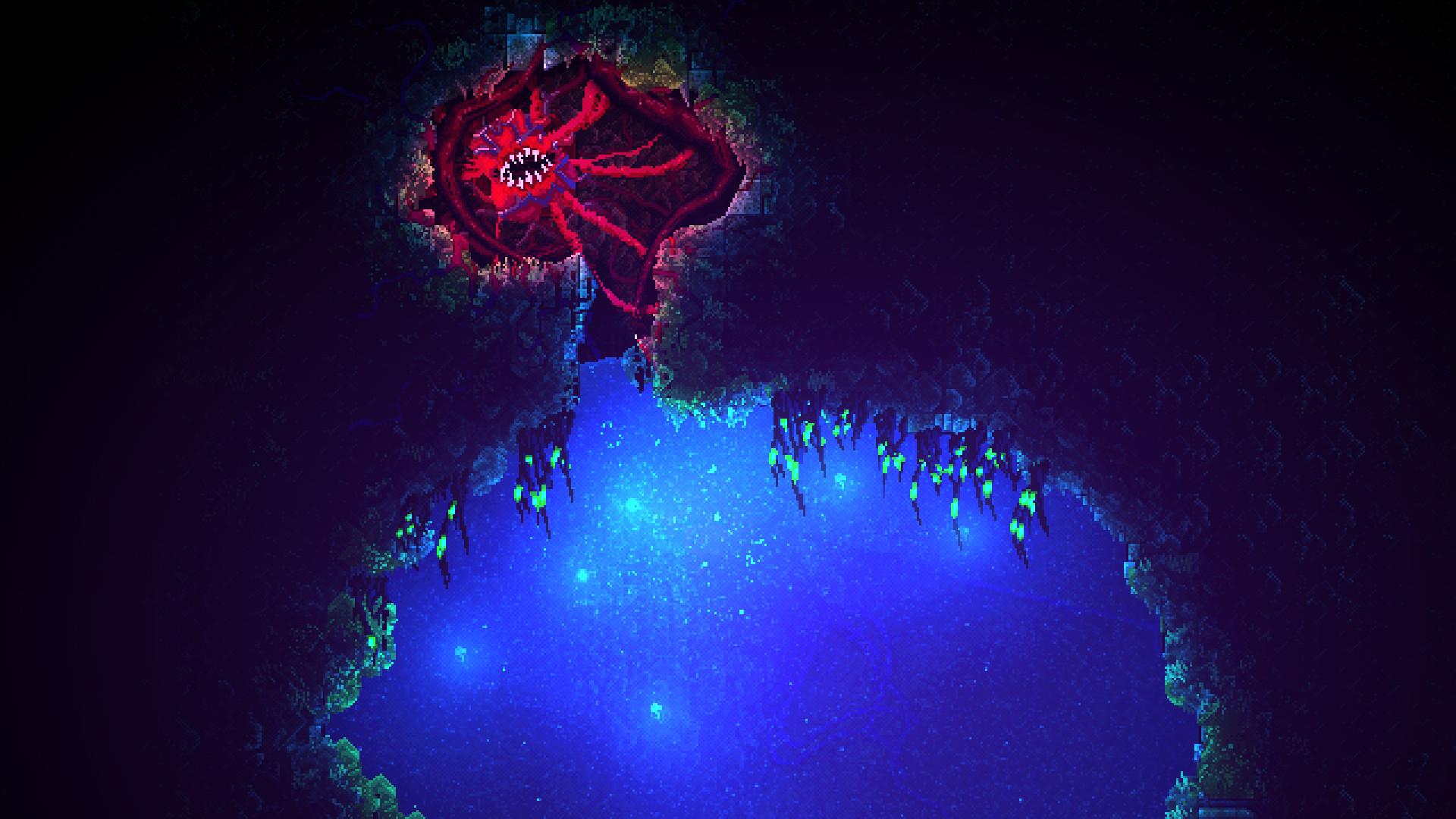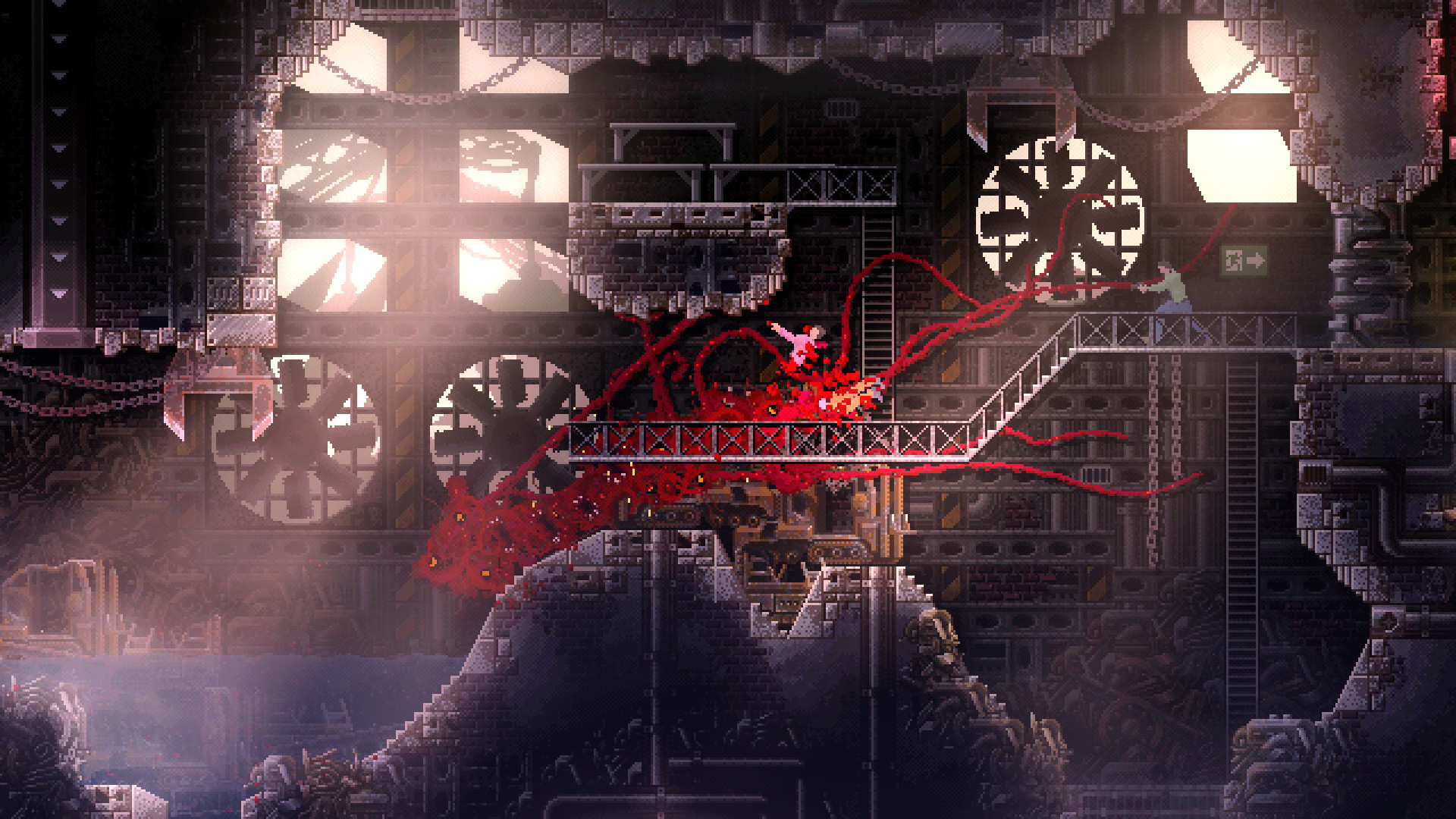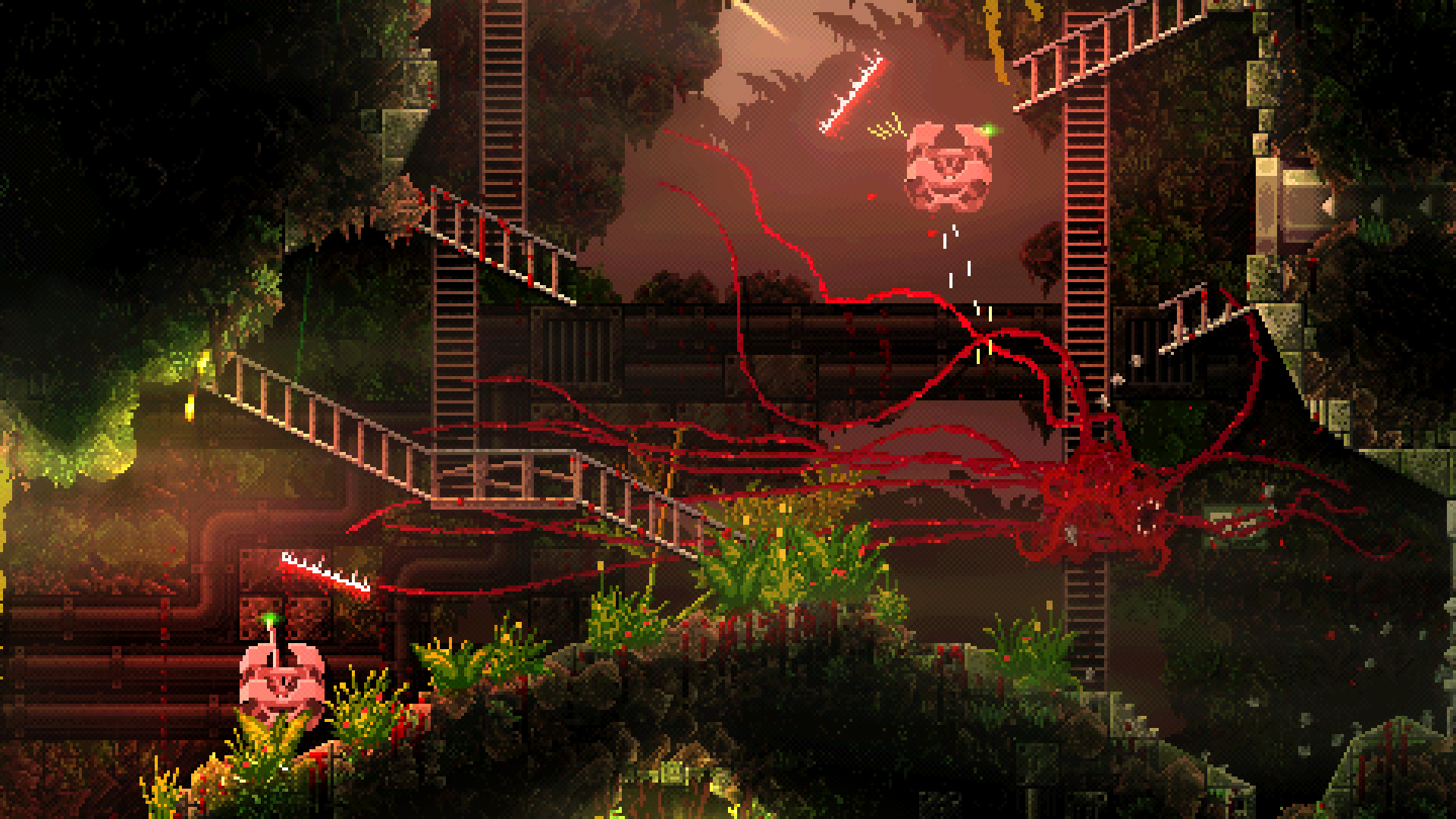Carrion is a reverse horror game in which you play as an amorphous creature of unknown origins. The game received universal acclaim from players and critics for its clever power-fantasy premise, as well as satisfying traversal and combat mechanics, which allow for gameplay that can be both strategic and chaotic.
The team behind the game is Polish developer called Phobia Game Studio, whose members previously shipped 2D platformer Butcher.
We caught up with Krzysztof Chomicki, game and level designer on Carrion, to discuss what it took to create the ultimate monster simulation experience of 2020. What follows below is the text version of the video interview that took place on August 13.
Krzysztof Chomicki, game and level designer on Carrion
Oleg Nesterenko, managing editor at GWO: Krzysztof, a couple of words about yourself and the studio, please.
I’m the game and level designer at Phobia Game Studio. We’re a very small development team based in Poland. We all work remotely. I’m based in Krakow, Sebastian Krośkiewicz, who is the brains behind the whole studio and our project, lives in Warsaw. Our sound designer, Maciej Niedzielski, is based in Zielona Góra, which is next to the German border. And on Carrion, video game and film composer Cris Velasco joined our team, he’s from LA. He did the music for the game.
Carrion team.
From left to right: project lead Sebastian Krośkiewicz, game/level designer Krzysztof Chomicki, composer Cris Velasco, sound designer Maciej Niedzielski
How did you first meet with Sebastian and decide to form a studio?
We both got hired a couple of years ago by Transhuman Design. It’s a company set up by Michal Marcinkowski. His studio is behind Soldat and Soldat 2, King Arthur’s Gold, and Trench Run. He hired Sebastian for a particular project, which eventually got scrapped, but at the time Sebastian was working on his own game called Butcher, and Michal liked it enough to decide to produce it as Transhuman Design and publish it.
Eventually, they decided to expand the team behind Butcher. They were looking for a level designer, and that’s how I got on board. At some point, Maciej joined the team as a composer. We liked working with each other so much that we decided to form our own studio, and that’s how Phobia and the core team behind Carrion came to be.
It’s been three weeks since you unleashed Carrion onto the world. What’s going on at the studio right now?
We’ve just published a major patch, which is live on Steam and Xbox already. It should be live on Switch fairly soon. We are also thinking about some updates, like workshop support for the Steam version.
But mostly, we just want to get the post-release support done and maybe the PlayStation port and then to take some time off.
The last couple of weeks was pretty intense. Especially since it was a multi-platform release, which we didn’t have previous experience with because Butcher was ported to consoles not by us, but by Crunching Koalas.
Just like Carrion, Butcher also had players kill people as an antagonistic entity, and it was a relative success. Does it mean that Carrion was a relatively low-risk project and you were confident that there’s a demand for this formula?
It’s not like we knew that a game about an amorphous meat blob would sell. When Sebastian started prototyping the monster’s movement and eating mechanics, he shared some gifs on Twitter. They clicked incredibly well, especially compared to what we had with Butcher. Soon after this, publishers started approaching us and asking about the game. “Yes, it’s still too early,” they said. “But once you have a vertical slice and some proper prototype demo, come back to us and we’ll see what we can do.”
That’s when we knew that there’s definitely a potential in this project.
You said before that early in development, you used real-time feedback on Twitter to help shape Carrion. How did it work?
At first, we weren’t sure what kind of game we wanted to make, other than it being loosely inspired by The Thing (1982). We were just exploring the controls for this amorphous creature. We also had the general idea for the eating mechanic, which is that you grow larger and more powerful as you eat more people. And that was pretty much the only thing set in stone from the very beginning.
Everything else we experimented with, posting some gifs on Twitter, and whatever resonated best with people clued us in on which direction we should follow.
Does the player control just one monster? Should there be more monsters? Should we make it an RTS game, with you commanding multiple creatures?
Interestingly enough, we didn’t implement any of the mechanics we were testing on Twitter. So, the core of the game has not changed since the very beginning. Twitter comments just validated our intuition, which led us to this kind of metroidvania-based exploration / puzzle platformer without platforming.
Carrion’s engine is built on the MonoGame framework. Would you please explain your choice of the tech behind the game?
Actually, Butcher, our previous game, was done in Unity. At the time we shipped Butcher and started looking into Carrion, Unity had its both advantages and disadvantages. The advantage was that you could get something up and running very quickly. However, optimizing it, finding bugs and general quirks of the engine wasn’t that easy. I don’t know if it’s still the case with the latest version.
For Butcher, Sebastian even developed his own 2D lighting system instead of using what Unity had built in. And it gave us a massive performance boost.
So Sebastian figured out that for the game to feel good on low-spec hardware, while having at least 60 FPS, with no frame drops, it would be easier for him to write something from scratch. He was doing it anyway. The engine was just giving us some unnecessary overhead.
Sebastian looked into MonoGame, liked it enough to decide to go with it, and we are pretty proud of how the game works on relatively crappy computers.
And there is also no fee for using MonoGame, which is always a bonus. I wouldn’t, however, recommend building your own engine for everything. It requires a particular set of skills. Sebastian being a very talented programmer, it worked out pretty well in our case. But I’m definitely not surprised that many teams are sticking with Unity, Unreal or GameMaker.
Unity and Unreal make most sense if you want realistic graphics. If you could have afforded it for Carrion, I wonder if you would have gone for the same level of gore and violence that you now have in the game?
To be honest, I don’t think it would have worked with extremely realistic graphics. It would’ve lost a lot of its charm and even comedy. Carrion is one of those games that might act as if they are dead serious, but they aren’t. With all the screams and everything being so over the top, it works very well in the pixel art style.
And I’m not sure it would be a good idea to do it either in high-def 2D or 3D. It would probably turn into an actual horror game, and we didn’t want our game to be scary to the player. You are the one who’s making NPCs scared, but you yourself should feel exhilarated running around as the monster. So I think this level of abstraction that pixel art gives us is very beneficial in this case.
Physics simulation creates all sorts of fun incidents, but it also takes away from the precision of controls. Like you try to gently close the door, but instead you rip it off! Or you occasionally expose one of your blobs. Did you struggle with that when designing the game?
90 or 95% of the monster is physics-based and procedurally generated. There’s a couple of sprites, like the mouths or the eyes. Obviously, it did pose some problems in terms of responsiveness. We did our best to give the players as much control over the creature as possible, given its nature. But it’s always a tradeoff.
There were also some quirks in level design. Especially with the monster in its largest form, we had to be very careful. For example, if you pull this switch and some door closes, it can cut you in half because some of your blobs just happened to be there, half a screen away. Things like that don’t happen in other games with regular-sized characters, which only fit two tiles. It was pretty tough for us.
As for somewhat loose controls, I think it actually works pretty well on the narrative level, because even if you want to remove a soldier or a scientist from a group and you just end up killing everybody, well, what can you do it? Just one of the disadvantages of being a monster, I suppose.
Yeah. Narratively and thematically, it fits, so it’s not a major problem. No ludo-narrative dissonance. Controls don’t need to be uber-precise since the monster is kind of messy.
You could do a crossover between Butcher and Carrion. Combine two very different types of gameplay with the cyborg from Butcher being very precise and the monster being sloppy and messy.
That would not be impossible to do… But I’m not confirming any crossovers! A good point, though, about Butcher’s controls being very precise. In Butcher, we had pixel-perfect precision when it comes to movement. And all the arenas and the platforms were designed with extremely smooth and precise movement in mind. Carrion is the opposite because the monster isn’t that precise and it doesn’t even require any platforms because it can just go anywhere it wants.
Technology versus nature. Anyway, I also like how many of Carrion’s systems are interconnected. The roar button, for example, lets you roar, which is fun in itself. At the same time, it allows you to locate a savepoint. But it also alerts NPCs on the level, which you can tactically use. Did you specifically design stuff like that to serve multiple purposes? Or did it just organically come together as the game evolved?
I think it’s a bit of both, depending on which system we are talking about. Some things were planned and some just came naturally as the game was evolving.
We knew quite early on that we’d lock particular skills into particular sizes of the monster. We call it the mass-based class system. This system allowed us to come up with more creative puzzles than in most metroidvanias, in which solving puzzles is just a matter of obtaining the right skill.
The mass-based class system also added more variety to combat because there isn’t one single winning strategy for all encounters. Puzzles force you into changing your size so you have to constantly adjust your tactic.
That’s something we knew pretty much from the get-go and something that was entirely planned. Other things kind of evolved along the way, like the echolocation. Initially, it was just a roar button and it didn’t have the echolocation functionality. That’s something that was added later on.
In general, we are big fans of things that serve multiple purposes and add some depth without adding unnecessary complexity. The fewer buttons to remember, the better.
What does it mean to create levels for a monster to navigate as opposed to those designed for humanoid characters?
It’s just a nightmare in many ways. One thing you don’t really think about is how important gravity is in most games, especially in action adventure platformers. It’s pretty much the most common obstacle other than having to fight enemies or open doors. You have to get somewhere high or avoid falling down. Gravity is something you take for granted, and once you take it away from the game, suddenly you have to figure out a completely new way of setting up challenges, obstacles and puzzles for the monster.
As the monster, when you see some place, you can just go there by pointing your mouse or analogue stick. It really flipped everything on its head. We couldn’t have actual outdoor segments because the monster could just go everywhere. So there’s always a ceiling, even in the most outdoor-ish chambers. Obviously, it’s a lot of work.
And also the sheer speed at which the monster moves is a major problem for level design. In most games, half of the time you just walk from point A to point B. In Carrion, though, it’s a matter of seconds to go from the beginning of the map to the end, if there are no obstacles, no enemies. So we had to get very creative.
You may have noticed that in flashback sequences, when you’re controlling the scientists, their movement is totally different, despite utilizing the same environments. A chamber that would take a second or two to traverse as the monster takes you half a minute to get through. So it amplifies the sense of what the monster is capable of and how frightening it is to the humans who move so slowly and are very limited in their traversal abilities.
So the metroidvania-like design was born out of your ambition to step up the challenge for the monster?
It wasn’t so much about upping the difficulty. We just wanted to give the game more depth, boost its exploration aspect. As soon as we figured that throughout the game the monster would be learning new skills that it could use to unlock new areas, to solve puzzles, it was just our natural instinct to go for a more or less metroidvania-like approach. Although it’s not really your ordinary metroidvania with everything respawning everywhere and every puzzle being extremely simple. We didn’t want to respawn every single object in the environment. We wanted to maintain this feeling of the horror that the monster is bringing on humans, so you need to see your havoc. Everything that you broke, everyone you killed and everybody you spared stays there for the whole game.
So despite Carrion having those core principles of metroidvania (not being able to go there yet, first needing to acquire the new skill), we kind of streamlined it. You don’t have to do an awful lot of backtracking in our game. Which is why, once you enter a new area, it’s locked off, and you are restricted to this contained area you have to work through. It lessens the confusion because it helps avoid situations in which someone would approach a puzzle and start wondering whether they can solve that puzzle or not yet. Because sometimes you backtrack to the very beginning even though you were actually able to solve this or that puzzle. It was just a matter of coming up with the right solution.
I did get lost a couple of times exploring the dungeons. And apparently, other people did. I saw folks posting their maps of the facility on Reddit to help their fellow players. In retrospect, do you feel like an in-game map might have been a good idea?
I’m fairly confident that some reviewers would have given us higher scores, if there was an in-game map. I still think it would really detract from the experience. It would make the game genuinely worse. It’s like with Demon’s Souls and Dark Souls, those games being vastly misunderstood at first by the majority of reviewers. Especially Demon’s Souls didn’t review all that well because the game didn’t explicitly tell you what to do. Those games didn’t have any maps. But eventually a few people figured out what those games were about. They were just hearkening back to times when games respected the player a bit more and didn’t do any kind of handholding.
In fact, you still have this conversation going on 10 years later, like should Sekiro have an easy mode? No, it shouldn’t.
And I think it’s kind of similar with Carrion. Games nowadays make people expect a map to guide you everywhere, even if it’s not really necessary. Players are so used to having a map that they stop paying attention to environmental clues or directions that the game gives them.
The original Metroid didn’t have a map and it was totally fine and nobody complained. Back in the day, even games that did have maps still required you to pay attention to the environment. In Morrowind, for example, the quest log only gave you the general directions, like go North, find this rock, and then turn right and hope for the best. It’s something that Oblivion totally ruined for me. It just points you in the right direction or you can simply fast-travel, there’s barely any sense of exploration and discovery in post-Oblivion RPGs. If more developers decided to focus on just environmental clues, people would stop expecting to have the map available at all times.
I’m very happy, though, that people are making their own maps to help each other, it strengthens the community.
Both Butcher and Carrion allow users to integrate their own custom levels. Is it a feature that you consciously put in your games?
In the case of Butcher, we used our own in-game level editor while making the game. It was relatively easy to adapt it to the general public. We just figured, why not? Anyway, it wasn’t very popular with fans, even though some people did make maps. And in the case of Carrion, it’s actually the total opposite. This time, we used a third party tool called Tiled, which is a map editor used in various games. Once we posted the alpha sneak peek demo back in October last year, someone asked what we were using for editing levels. When I told them it was Tiled, people started coming up with their own maps, using the demo assets. We didn’t lock any functionalities away from people. People are still making maps. The most dedicated modder in our community has already made a custom campaign, which should take around two hours to beat or so, and it’s very cool. So it’s something we want to capitalize on, which is why we’re looking into the workshop support, as I mentioned.
We definitely want to make creating and downloading custom maps easier. It’s not so hard right now, you need to download a level file and the script file and put them in the corresponding folders. But nowadays it’s expected that everything should be just a single click away, so we’re looking into our options in making the whole experience smoother.
A couple of words about music and sound design. How did it feel for you guys to work with Cris Velasco?
It was great. Cris did music for Overwatch, Mass Effect, Borderlands, God of War, Resident Evil 7, and Bloodborne. What he brought to the table is the sheer knowledge of working on those AAA titles. In fact, we wanted to orchestrate the whole soundtrack. We pretty much had everything set up for an actual orchestra recording. But the pandemic messed up our plans and we ended up recording soloists only — a violinist and a cellist.
Funnily enough, it was Cris who approached us after seeing some of our gifs on Twitter. He found Sebastian on FB and said he would like to write the soundtrack for Carrion. After seeing his portfolio, we obviously decided to let him!
When the credit rolled, I counted 16 voice actors in the game without a line of dialogue. How come?
It’s all screams. We told our sound designer Maciej that there’s a limit on every sound. There’s only this many sounds for door breaking, wood cracking or the monster roaring. But there was one sound that didn’t have a limit on the quantity and variety of it. It was screaming. We wanted to have as many screams as possible. When we revealed the game at an E3, we didn’t have all those recorded yet, and people actually complained about having to listen to the same samples over and over again. It’s something we went all in on.
Finally, any words of wisdom to your fellow devs?
Never make games in which the character is amorphous and you never know how large and how long it gets. Stick to your fixed-sized character. It’s for your own sanity.
***
You mignt want to check out the extended video version of the interview with Krzysztof:







